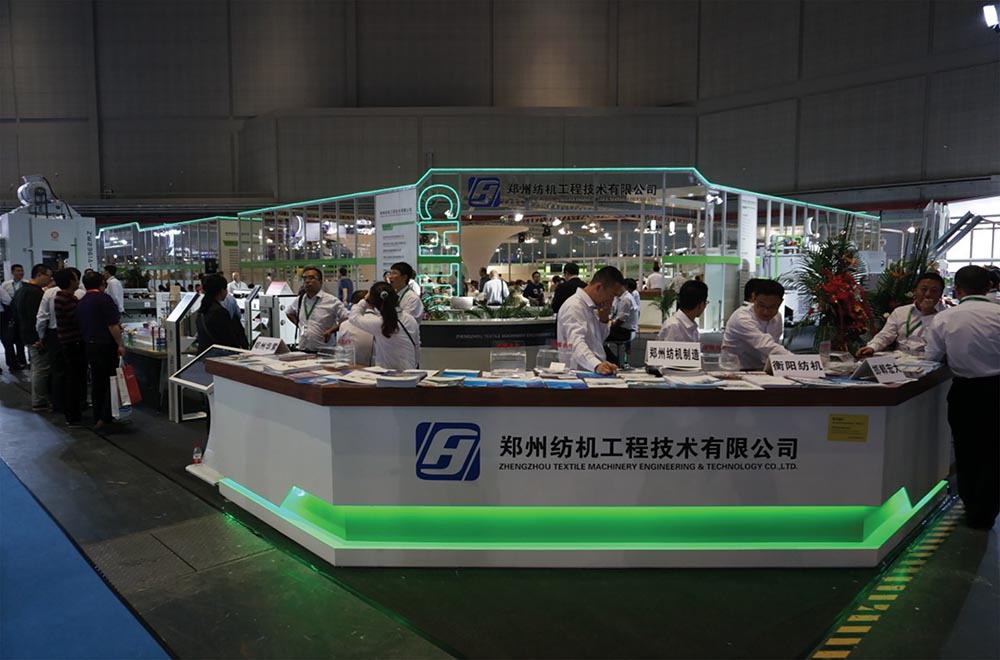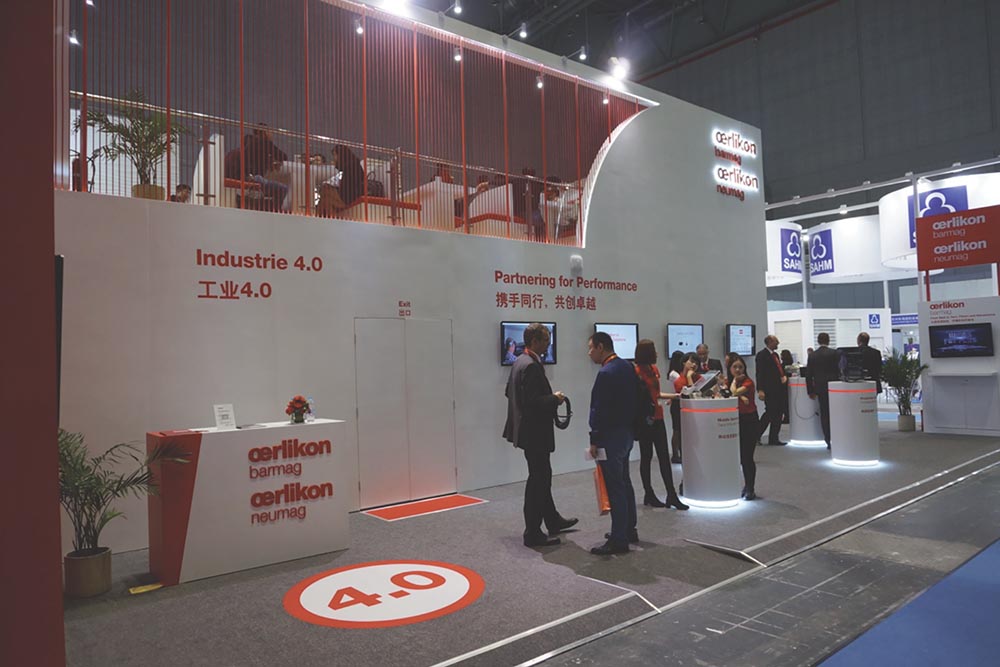ITMA ASIA + CITME 2016 held at the National Exhibition and Convention Center in Shanghai.
During the ITMA ASIA + CITME 2016 event held October 21-25 in Shanghai, the number of exhibitors and the exhibition area both reached historical highs, showing the stable growth of the global and Chinese textile, chemical fiber, and related machinery industries.
This was the first time the event was held at the new National Exhibition and Convention Center (NECC), which is one of China’s largest and most state-of-art exhibition centers. The exhibition center was first put into trial operation in October 2014, and then fully open to the exhibition business in March 2015, with a total exhibition area of 500,000 square meters.
Exhibitors
According to the organizers, 1,673 exhibitors from 28 nations and regions attended the event, covering 170,000 square meters in 6 halls (Hall 1-6) of the NECC. The machines of chemical fibers and nonwovens were located in Halls 1 and 2. By comparison, the last exhibition, the ITMA ASIA + CITME 2014, had 1,550 exhibitors covering 152,000 square meters in 13 halls of the Shanghai New International Expo Center (SNIEC).
Main organizers and sponsors of the exhibition included: China Textile Machinery Association (CTMA), Le Comité Européen des Constructeurs de Machines Textiles (CEMATEX), the Sub-Council of Textile Industry, China Council for the Promotion of International Trade (CCPIT TEX), China International Exhibition Center Group Corporation (CIEC), Japan Textile Machinery Association (JTMA), Beijing Textile Machinery International Exhibition Co., Ltd., and MP International Pte. Ltd.
The organizers estimated that there were over 100,000 professionals, from about 100 countries, visiting the ITMA ASIA + CITME 2016 in the five-day long event.

Chinese market
This was the first important textile machinery show in China in the 13th Five Year Period (2016-2020), said Wang Shutian, president of CTMA. He said that the ITMA ASIA + CITME 2016 perfectly interpreted China’s six main focuses of the textile industry for the coming five years. These focuses include: smart spinning lines, smart polyester filament lines, smart knitting lines, automated printing and dyeing lines, automated nonwoven lines, and automated garment production lines.
CTMA published an important report for the Chinese textile machinery industry – the Guide of the Development of the Textile Machinery Industry in the 13th Five Year (the Guide) – earlier this year. Among the total of 59 key technologies China wants to acquire, eight technologies are related to the manufacturing of manmade fibers. They include:
- China will be able to produce the complete equipment set of cellulose fiber production line based on new solvent method with an annual capacity of more than 10,000 metric tons. According to the Guide, China should be able to set up at least one such facility, with an annual capacity of 30,000 metric tons, by 2020.
- Chinese machinery companies will be able to produce the equipment for dope dyeing (solvent carrier-type) PET fibers by 2020.
- Chinese machinery companies will develop remote monitoring and control systems for chemical fiber equipment in the next five years.
- China will be able to produce industrial-scale complete equipment set to produce carbon fibers by 2020.
- China will develop the complete equipment set for producing carpet yarns in the next five years.
- China will be able to produce the spinning machines for the filaments and staple fibers of polylactic acid (PLA) by 2020.
- China will develop a high-speed winding system for chemical fiber filament in the following five years.
- China will increase the speed of mechanical wrapping machines for yarns in the next five years.
According to the Guide, by 2020 the Chinese textile machinery industry will have annual sales of 150 billion yuan ($22 billion), with export of $3.5 billion. Domestic machinery is expected to dominate the Chinese market, with a share of 80%, by 2020.
China’s production of chemical fibers reached 48.3 million metric tons by 2015, growing at a compound annual growth rate (CAGR) of 9.3% from the 30.9 million metric tons in 2010, according to the China Chemical Fiber Association (CCFA). Chemical fiber machinery producers from both China and outside China have enjoyed the booming Chinese market for the last five years.
But the growth will slow down. Duan Xiaoping, president of CCFA, said the growth rate could be at as low as 3.3% per year in the next five years, as China’s production of chemical fibers have overtaken 70% of the global production and the market has been saturated.
Duan explained in a conference early this year that the slowdown would not necessarily be bad news to the chemical fiber and the machinery industry. Fast-growing markets had led to too many facilities and capacities installed in the last five years, and the chemical fiber industry had grown to severe overcapacity. A slower growth could calm down investors and make the investments wiser and more reasonable, and production could grow faster than capacity in the next five years, which could make the chemical fiber industry more profitable than in the last few years. Because of slowdown, machinery companies may have to change their strategies to focus more on the value-added products that help chemical fiber manufacturers increase their profits. CTMA’s goals for the next five years have partly catered for this important trend.

Global market
The global fiber processing volume will continue to grow at around 3% per year in the next 10 to 15 years, according to CCFA. This means that the global fiber processing volume could reach, respectively, 122 million metric tons in 2025 and 142 million metric tons by 2030.
According to the Japan Chemical Fibers Association (JCFA), the global fiber processing volume reached 90.59 million metric tons by 2015, with 73.4% of chemical fibers (66.47 million metric tons) and 26.6% of natural fibers (24.12 million metric tons). Chemical fibers grew at a CAGR of 6.9 from 47.69 million metric tons in 2010 to 66.47 million metric tons in 2015, while natural fiber declined from 26.14 million metric tons to 24.12 million metric tons. This trend shows that chemical fibers is very likely to take almost all the increased fiber processing volume in the next five or more years. Therefore, the production of chemical fiber and natural fiber could reach, respectively, 98 million metric tons and 24 million metric tons by 2025, which means that the production of Chemical fibers will grow at a CAGR of about 4% in the next decade. Though the market will be much slower than the previous five or ten years, there will be still a good potential for the chemical fiber manufacturers and the machinery suppliers around the world.
Different sources have given different numbers of production. For example, the European Man-Made Fibres Association (CIRFS) estimates that the chemical fiber production was 68.9 million metric tons in 2015. However, the difference is relatively small and will not affect much on the general situation and the forecasts of the global market.
The global chemical fiber production shares by country in 2015 are estimated in the Table 1 below:
Table 1: The global chemical fiber production share in 2015
| Country | Share |
| China | 72.7% |
| India | 6.4% |
| Europe | 5.1% |
| The United States | 3.0% |
| Taiwan | 2.9% |
| Indonesia | 2.8% |
| South Korea | 1.9% |
| Thailand | 1.5% |
| Japan | 1.1% |
| The rest of the world | 2.6% |
| Total | 100% |
Sources: International Fiber Journal, CCFA, JCFA, CIRFS
Solutions for the future
The slower but more mature manmade fiber industry will have increased demands for the more sophisticated machinery solutions with value-add features. Machinery manufacturers have shown a series of new solutions and products in the exhibition. For example, Oerlikon Manmade Fibers presented its innovative Industry 4.0 system control and customer services solutions that allow fiber producers to increase productivity, save energy and deploy resources efficiently by maintaining a constant overview of all processes, from polycondensation, spinning and texturing all the way through to downstream processing procedures. Oerlikon also presented numerous other solutions to produce POY, FDY, DTY, industry yarn (IDY), meltblown nonwoven, carbon fiber and aramid at ITMA Asia + CITME 2016.
The slowdown of the chemical fiber industry also means the increasing demand for production differentiation and flexibility. Polytex is such a machinery company that provides new solutions for the changing fiber industry. Severe competition and the slowdown in the global polyester market have forced major manufacturers to give up their old strategy of buying large-capacity facilities for producing regular polyester fibers. The manufacturers now demand more for better flexibility with differentiated products. To follow this market trend, Polytex has developed a system that can manufacture multiple products such as film-grade, bottle-grade, fiber-grade and specialty polyester products in just one single production line.


